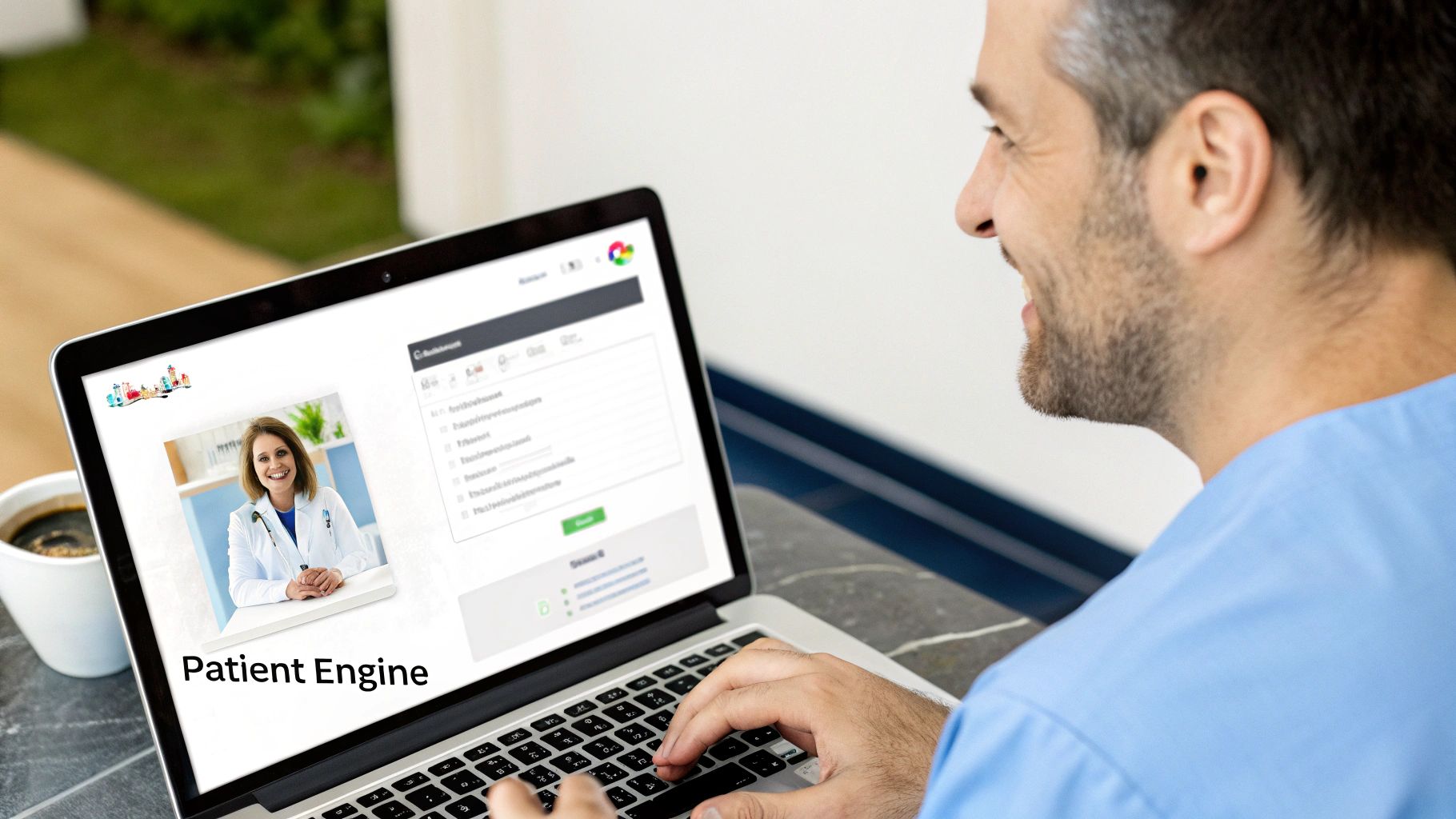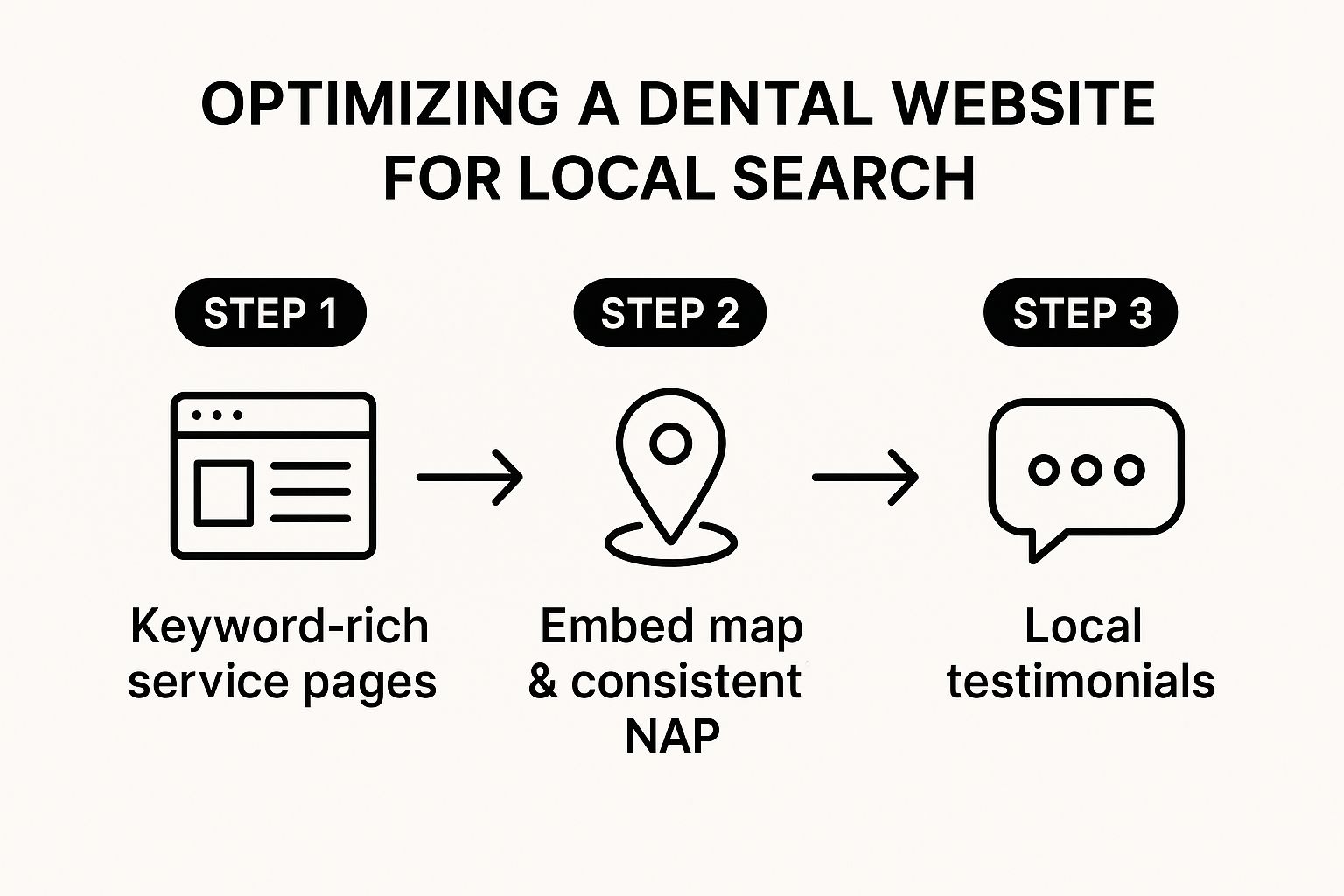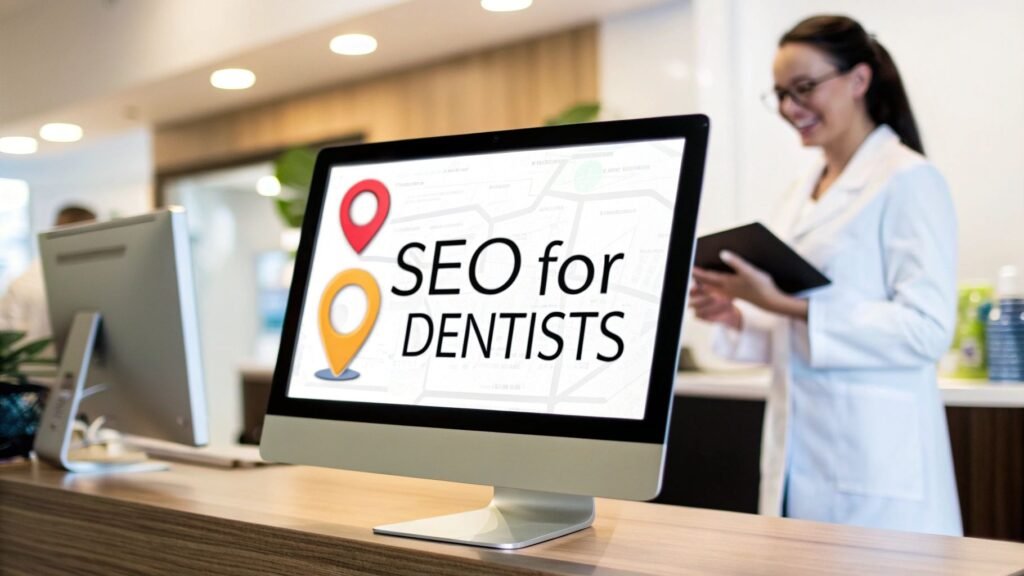Local SEO for dentists is the art and science of making your clinic the most visible and trusted choice when potential patients in your area search online. It’s a strategic process designed to place your practice in Google's coveted "map pack" and at the top of organic search results, connecting you directly with local patients at the precise moment they need dental care.
A robust local SEO strategy isn’t just about being found; it’s about being chosen. It ensures that when someone searches "emergency dentist near me" or "best cosmetic dentist in [Your Suburb]," your clinic is the first and best answer.
Why Local SEO Is Your Best New Patient Magnet

Let's be clear: the era of relying solely on word-of-mouth and a Yellow Pages ad is over. When a patient experiences a dental emergency or decides it’s time for a cosmetic consultation, their first action is to pull out their smartphone and search Google.
This fundamental shift in patient behavior makes local SEO an essential business strategy, not just a marketing add-on. For journalists covering business trends, the data is stark: a survey by BrightLocal found that 98% of consumers use the internet to find information about local businesses. For a high-trust service like dentistry, this online research phase is non-negotiable for patients.
Think of your position in Google's local results, particularly the "map pack," as your digital storefront. It's the first impression you make on a potential patient actively seeking your services. If you're not there, you're invisible to a huge portion of your local market.
The Modern Patient Journey Starts Online
Today’s patient journey is almost entirely digital. Prospective patients use Google to find emergency dentists, research complex procedures like dental implants, read peer reviews, compare clinics on a map, and check your opening hours before even considering making a phone call. A passive online presence is no longer sufficient.
The data for the Australian dental market tells a powerful story of digital dominance. The top three organic search results on Google capture the lion's share of clicks. A dental practice ranking #1 on Google gets around 28.5% of all clicks. This drops to 15.7% for the second spot and just 11% for the third. This steep decline highlights the immense value of securing a top position.
"For any journalist looking at the state of local business, here's a key statistic: if your dental clinic isn't on the first page of local search results, you are effectively handing over 90% of your potential new online patients to your direct competitors. It's a battle for digital visibility, and Google’s algorithm is the battleground."
The Core Pillars of a Winning Strategy
A successful local SEO for dentists strategy is built on key pillars that work together to prove your relevance, expertise, and authority to search engines. Mastering these elements is what places your clinic in front of patients at the exact moment they need you. While a comprehensive strategy involves many details, our guide on local SEO for small business provides a great overview.
To get started, let's break down the fundamentals. A strong local SEO campaign always revolves around four core components.
| SEO Pillar | Primary Focus | Key Goal |
|---|---|---|
| Google Business Profile | Your GBP listing | Dominate the Google "map pack" with a complete, active, and trusted profile that converts searchers. |
| Website & On-Page SEO | Your website's content and technical health | Rank for local keywords and provide a seamless user experience that turns visitors into booked appointments. |
| Reputation & Reviews | Patient reviews on Google and other sites | Build overwhelming social proof and trust that influences both prospective patients and search engine rankings. |
| Citations & Backlinks | Your clinic's online mentions | Establish local authority and credibility through consistent business information and links from reputable sources. |
By focusing your efforts on these four areas, you build a powerful, sustainable system. This system is designed to consistently attract high-intent local patients, turning their online searches into booked appointments and putting your clinic on a significant growth trajectory.
Turning Your Google Profile Into a Patient Engine

Your Google Business Profile (GBP) is not merely an online directory listing. It is the single most powerful tool in your arsenal for local SEO for dentists. Think of it as the digital front door to your practice. When someone in your suburb searches for a dentist, your GBP is often the very first, and most influential, piece of information they see.
A bare-bones profile is a catastrophic missed opportunity. A fully optimized profile, however, becomes a 24/7 patient-generating machine. It works tirelessly to build trust, answer critical questions, and secure appointments—often before a user even needs to click through to your website.
Beyond the Basics of Your Profile
Claiming your profile is just the first step. The real competitive advantage comes from strategic optimization. This begins with selecting the right service categories.
Don't settle for the generic "Dentist" category. Be specific. If you specialize in cosmetic procedures or orthodontics, add secondary categories like "Cosmetic Dentist," "Orthodontist," or "Dental Implants Provider." This granularity helps Google match your clinic with high-intent searches, such as a patient searching specifically for "Invisalign treatment in Parramatta."
Your business description is another strategic asset. Don't just list your services—articulate your unique value proposition. What makes your practice different? Perhaps you offer sedation dentistry for anxious patients or utilize advanced CEREC technology for same-day crowns. Weave in your primary keywords naturally, focusing on the high-value services you want to be known for.
Using Google Posts to Drive Action
Google Posts are free, high-visibility micro-advertisements that appear directly on your profile. The majority of dental practices neglect this feature, giving you an easy competitive edge. Use Posts to highlight special offers, practice news, or patient education.
Here is a step-by-step guide to creating an effective Google Post:
- Log in to your Google Business Profile dashboard.
- Select "Add update" from the options.
- Choose a Post Type: "Offer," "Update," or "Event." For a promotion, "Offer" is best as it allows for start/end dates.
- Craft a Compelling Headline: E.g., "Free Invisalign Consultation This Month!"
- Write Concise Copy: Get straight to the point. "Book your free Invisalign consult in August and receive a complimentary professional whitening kit (valued at $250). Spots are limited!"
- Add a High-Quality Image or Video: Use a real photo of your team or clinic.
- Include a Call-to-Action (CTA): Use buttons like "Book," "Learn More," or "Call Now." Link the "Book" button directly to your online booking page.
Proactively Managing the Q&A Section
The Questions & Answers section on your GBP is a goldmine for addressing patient concerns upfront. The key is to be proactive; don't wait for questions to be asked. Populate this section yourself.
Think of the most common questions your front desk team answers daily. This is your content plan.
"Your GBP's Q&A section is your chance to control the narrative. By pre-emptively answering common patient anxieties about cost, pain, or insurance, you remove barriers to booking and build instant trust with people researching their options."
Seed this section with these questions and provide clear, reassuring answers. For instance:
- Q: "Do you offer payment plans for major dental work?"
- A: "Yes, we do! We offer flexible, interest-free payment plans through [Payment Provider Name] to help make your treatment more affordable. Our treatment coordinator can walk you through the options during your consultation."
- Q: "Is teeth whitening safe if I have sensitive teeth?"
- A: "Absolutely. We use a professional-grade whitening system specifically designed to minimise sensitivity. Our dentists will assess your situation to ensure a comfortable and effective treatment."
Curating a Gallery That Builds Trust
Never underestimate the power of photos. A professional photo gallery can be the deciding factor for a nervous patient. Stock photos are a liability; they feel impersonal and erode brand trust. Your gallery should be an authentic window into your practice.
High-quality, genuine images are non-negotiable. Research shows that business profiles with more than 100 photos get 520% more calls and 2,717% more direction requests than the average business. That is a staggering difference.
Focus on showcasing:
- Your Welcoming Team: Professional but approachable headshots of your dentists, hygienists, and support staff.
- The Clinic Environment: Clean, modern, and comfortable shots of your reception area and treatment rooms.
- Your Advanced Technology: Photos of any state-of-the-art equipment (e.g., 3D scanners, intraoral cameras).
- The Exterior: A clear photo of your building and entrance so new patients can easily find you.
When you transform your GBP from a static listing into a dynamic, informative hub, it becomes one of your most valuable marketing assets, directly boosting local rankings and converting searchers into scheduled patients.
Optimising Your Website for Local Searches
While your Google Business Profile earns the first click, your website must close the deal. It's the digital handshake that needs to be professional, reassuring, and flawlessly clear to convert a curious searcher into a new patient. On-page SEO is how you signal to Google that your clinic is the definitive authority for dental services in your specific geographic area.
This is far more than keyword stuffing. It's about architecting your website to directly answer the specific questions local patients are asking. This means building out dedicated, compelling service pages that target high-value local searches like "cosmetic dentistry in Bondi" or "emergency dental care in Fitzroy."
Creating Hyper-Local Service Pages
Generic service pages are obsolete. To achieve true local dominance, each page must function as a dedicated resource for a specific service in a specific location. A patient searching for Invisalign has zero interest in your root canal information; they demand direct, relevant answers immediately.
The strategy is to build a distinct page for every core service you offer. For example:
- Dental Implants in Richmond: This page should detail your implant process, feature a gallery of before-and-after photos of your actual Richmond patients, and include an FAQ section addressing common questions about cost, longevity, and recovery.
- Teeth Whitening in South Yarra: This page should showcase your whitening technology (e.g., Zoom!), feature video testimonials from local South Yarra residents, and have a clear call-to-action to book a consultation.
This targeted approach not only helps you rank for valuable "money" keywords but also provides a superior user experience. When a user lands on a page that speaks directly to their precise need and location, it sends a powerful positive signal to Google. For a deeper dive, our on-page SEO checklist is an excellent resource.
The infographic below illustrates this process, showing how to structure your site to attract and convert local search traffic.

This visual guide emphasizes a core principle: winning a local patient is a journey that begins with targeted content and culminates in trust.
The Non-Negotiables for Local Trust
To execute on-page SEO correctly, you must embed specific trust signals throughout your website. These are the foundational elements that communicate to both patients and search engines that you are a legitimate, active local business.
Here is a detailed guide to implementing the core on-page elements:
On-Page Local SEO Checklist for Dentists
| Element | Implementation Guide | Impact on SEO |
|---|---|---|
| Consistent NAP | Your Name, Address, and Phone Number (NAP) must be identical in the footer of every page. Use schema.org markup to explicitly define each element for search engines. | This is the bedrock of local SEO. Inconsistency is the #1 reason businesses fail to rank locally as it confuses Google. |
| Embedded Google Map | On your contact page, embed a dynamic Google Map pointing to your Google Business Profile listing, not just a generic address. | Provides a direct, powerful signal to Google confirming your physical location and service area. |
| Localised Testimonials | Display patient reviews that mention their suburb (e.g., "Jane D., Fitzroy"). Use testimonial schema markup to help these appear in search results. | Reinforces your geographic relevance for searches like "best dentist Fitzroy" and provides powerful social proof. |
| Local Schema Markup | Implement "Dentist" or "MedicalClinic" schema on your site. This structured data explicitly tells search engines your address, hours, services, and reviews in their language. | This dramatically increases your chances of appearing in rich results and map packs, improving visibility and click-through rates. |
| Location in Title Tags | Your homepage title tag should be: "Dentist in [Suburb/City] | [Your Clinic Name]". Service pages should be: "Dental Implants in [Suburb] |
| Hyper-Local Content | Write blog posts about local health initiatives, sponsoring a local sports team, or oral health tips relevant to your community (e.g., "Protecting Your Teeth During Footy Season in Melbourne"). | Establishes your practice as an integral part of the local community, building authority and trust beyond just being a service provider. |
Implementing this checklist sends the strongest possible signals to Google about your location and expertise, positioning you to attract local patients.
Leveraging Local Patient Stories
Patient testimonials are your most potent form of social proof. Maximize their SEO value by always including the patient's suburb.
Consider the difference:
- "Great experience with Dr. Smith." – Jane D.
- "Dr. Smith is the best dentist in Fitzroy. The whole team made me feel comfortable." – Jane D., Fitzroy
The second example directly links your quality of care to a specific geographic location. This reinforces your local relevance for searches like "best dentist Fitzroy" and builds a powerful layer of community trust. Feature these localized testimonials prominently on your homepage and relevant service pages.
A well-optimized website gives visitors immediate confidence. This reduces bounce rate—a key metric indicating user satisfaction—and is crucial for converting a click into a new patient booking.
Building Trust with Citations and Online Reviews

In the world of local SEO, trust is a quantifiable ranking factor. Two of the most powerful signals of trust you can send to Google are your local citations and your online reviews. Together, they serve as third-party validation that your dental clinic is a legitimate, respected, and active member of the local business community.
Think of it this way: when Google consistently finds your clinic's details across multiple trusted websites, it grows more confident about your location and legitimacy. When it then sees a steady stream of positive patient feedback, it trusts the quality of your services. This combination is what propels you to the top of the local map pack.
Mastering Local Citations for Your Practice
A local citation is any online mention of your practice's Name, Address, and Phone number (NAP). The non-negotiable rule is absolute consistency. Even a minor variation, like using "St" on one directory and "Street" on another, can create conflicting signals that confuse search engines and dilute your authority.
Your NAP must be identical everywhere, from your Google Business Profile and website footer to every online directory. This meticulous consistency reinforces your geographic relevance. While global directories like Yelp are important, targeting Australian-specific and health-focused directories is key to building local authority.
Ensure your practice is listed with a consistent NAP on these high-value Australian directories:
- TrueLocal: A popular and well-regarded Australian business directory.
- Yellow Pages Australia: Still a foundational citation source for local businesses down under.
- Word of Mouth Online (WOMO): A review-focused directory that carries significant weight with local consumers.
- Healthdirect Australia: A government-funded health information service, which lends immense credibility.
"For journalists covering small business marketing, a critical takeaway is that citation strategy has shifted from quantity to quality. A dental practice with a perfectly consistent NAP on 20 high-authority, geographically-relevant directories will outperform a competitor with 100 inconsistent listings on low-quality, generic sites. It's about precision, not volume."
This process confirms to Google that you are exactly who and where you say you are—a cornerstone of effective local SEO for dentists.
A Practical System for Managing Online Reviews
Positive reviews are the modern-day word-of-mouth, directly impacting your revenue. A study by Dixa found that 93% of consumers say online reviews influence their purchasing decisions. In a high-trust field like dentistry, this is amplified.
So, how do you get them? You must ask. The perfect time is immediately after a positive patient experience. Implement a simple, automated system using a follow-up email or SMS that links directly to your Google review page.
Responding to every single review—positive or negative—is just as crucial. It demonstrates that you are engaged and value patient feedback.
Responding to Glowing and Critical Feedback
For positive reviews, a personalized response is best. Acknowledge a specific point they made, but always protect patient privacy by never mentioning their specific treatment.
Negative reviews require a careful, strategic approach. The goal is to acknowledge the issue publicly and immediately move the conversation offline. A simple script is most effective:
- Acknowledge and Apologise: Start by apologising for their negative experience.
- Show Empathy: Express that you take their feedback seriously.
- Take it Offline: Provide a direct contact to resolve the issue privately.
It’s crucial to handle these situations with care. If you're ever unsure of your options, it's worth learning more about whether you can remove Google reviews.
Example Response to a Negative Review
"Hi [Patient Name], thank you for your feedback. We are very sorry to hear that your experience did not meet your expectations. Providing excellent patient care is our highest priority, and we would appreciate the opportunity to discuss this with you directly. Please contact our practice manager, [Name], at [Phone Number] at your convenience so we can work to make this right."
Finally, leverage your best reviews as powerful social proof. Feature them prominently on your homepage and on relevant service pages. A glowing review placed next to your "Dental Implants" service description can be the final piece of persuasion a potential patient needs to book an appointment.
How to Measure SEO Success and Adapt to Changes
Local SEO is not a "set it and forget it" task. It is a continuous cycle of implementation, measurement, and adaptation. Google's algorithms are in a constant state of evolution, and strategies that are effective today may become obsolete tomorrow. Success requires a commitment to data-driven decision-making.
The goal is not to chase vanity metrics like a general increase in website visitors. True success in local SEO for dentists is measured by tangible business outcomes: more phone calls, more online appointment bookings, and a quantifiable increase in new patient revenue.
Responding to Major Algorithm Updates
Google periodically rolls out "core updates" that can significantly alter search rankings. These updates are designed to improve result quality, often by placing greater emphasis on user experience (UX), content quality (E-E-A-T: Experience, Expertise, Authoritativeness, Trustworthiness), and a site's overall helpfulness.
The August 2023 core update was a prime example, heavily impacting dental websites across Australia. Practices with technically sound, mobile-friendly websites rich with high-quality patient resources saw their rankings remain stable or even improve. Those with thin content or poor user experience were often penalized.
In a notable case study, some clinics that adapted their strategy post-update saw up to a 200% increase in organic traffic. By integrating a hybrid SEO approach with targeted Google Ads, one practice generated approximately 210 new patient appointments in just six months. You can explore more about these findings and their implications for the Australian dental market.
"The key takeaway from recent Google updates is a clear mandate for user-centricity. For a dental clinic, this means creating content that genuinely answers patient questions, ensuring the website is effortless to use on a mobile device, and providing overwhelming proof of local authority and expertise."
Tracking the Metrics That Actually Matter
To determine the ROI of your SEO efforts, you must track the correct Key Performance Indicators (KPIs). For a local dental practice, success is measured by a handful of critical metrics, most of which are available for free through Google Analytics and Google Business Profile Insights.
Focus your analysis on these three core areas:
-
Google Business Profile Actions: This is your direct lead generation channel. Track the number of phone calls, requests for driving directions, and website clicks originating from your GBP listing. A consistent upward trend in these actions is a clear indicator of improving local visibility.
-
Organic Traffic to Key Service Pages: It's not about total traffic; it's about the right traffic. Use Google Analytics to monitor organic (non-paid) traffic specifically to your high-value service pages, such as "Dental Implants" or "Cosmetic Dentistry."
-
Local Keyword Rankings: While rankings fluctuate, you should see a sustained upward trend for your most critical local keywords (e.g., "emergency dentist Richmond"). Tools like Semrush or Ahrefs are invaluable for monitoring your rank for these revenue-driving terms.
A Real-World Case Study in Adaptation
Consider a dental clinic in a competitive Brisbane suburb. Their rankings had plateaued despite having a decent website. Following an algorithm update, they observed a concerning dip in traffic. Instead of panicking, they analyzed their data.
The insights were clear: their "Invisalign" service page had an extremely high bounce rate on mobile devices, and a significant number of calls from their GBP were coming in after hours and going unanswered.
Their data-driven response was swift and strategic:
- They completely redesigned the Invisalign page for a mobile-first experience, adding a prominent click-to-call button, a simple contact form, and embedded video testimonials.
- They integrated an after-hours chatbot on their website and enabled Google's call history feature to track and return every missed call from their GBP listing.
The results were dramatic. Within three months, appointment bookings for Invisalign originating from organic search increased by 40%. Furthermore, they successfully converted 15 new patients from the previously missed after-hours calls alone.
This case study exemplifies the power of using data not just to measure performance, but to actively adapt and refine your strategy. This is the core of a successful, long-term local SEO plan.
Common Questions About Local SEO for Dentists
After covering the core strategies, from optimizing your Google Profile to building trust with reviews, specific questions often arise. This section addresses the most common queries we receive from dentists across Australia, providing clear, actionable answers.
How Long Does Local SEO Take to Work?
This is the most frequently asked question. While some optimizations, like a fully revamped Google Business Profile, can yield noticeable results in the Map Pack within a few weeks, true, sustainable local SEO is a long-term strategy.
A realistic timeframe to see significant momentum—such as a measurable increase in new patient calls and rankings for competitive keywords—is typically three to six months. It is critical to view local SEO for dentists as an ongoing investment, not a one-time project. Consistency and patience are paramount.
The power of SEO lies in its compounding effect. The initial months are about building a strong foundation: cleaning up citations, optimizing on-page elements, and establishing a review generation process. The significant returns, like a consistent, predictable flow of new patients, materialize as these efforts build upon each other over time.
Do I Really Need a Blog on My Website?
Strictly speaking, no. However, a strategic blog is one of the most powerful tools available for achieving local search dominance. The fact that many dentists neglect this presents a significant competitive opportunity.
A blog allows you to build topical authority. It's your platform for creating content that answers the exact questions local patients are typing into Google. Consider creating practical, geo-targeted articles such as:
- "The Average Cost of Dental Implants in Sydney: A 2024 Guide"
- "How to Find a Kid-Friendly Dentist in Melbourne's Inner Suburbs"
- "Are Porcelain Veneers Worth It? A Brisbane Dentist's Expert Opinion"
This type of hyper-local content achieves two crucial goals. First, it attracts highly relevant organic traffic from users with specific, high-intent queries. Second, it signals to Google that you are the definitive local expert on these topics, which boosts the authority and ranking potential of your entire website.
Should I Focus on Google or Other Review Sites?
For local SEO, Google reviews are unequivocally the most important. Your primary focus must be on generating a consistent stream of reviews for your Google Business Profile, as they directly influence your ranking in the Google Maps "local pack."
The local pack is often the first thing a potential patient sees when they search for a dentist. Your average star rating and the total number of reviews are massively influential factors in their decision-making process.
While having a presence on other platforms like Yelp or Healthgrades is beneficial for your overall online reputation, these should be a secondary priority. Dedicating your primary effort to your Google Business Profile will deliver the greatest return on investment in terms of local visibility and new patient acquisition.
Ready to turn local searches into new patients? The team at The Brand Express specialises in creating data-driven SEO strategies that deliver real commercial impact for dental practices across Australia. Let's build a plan to get your clinic seen.
